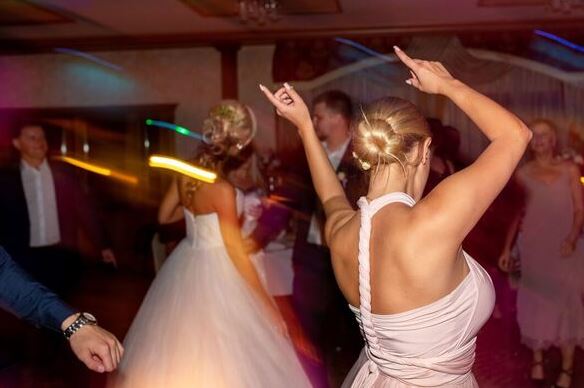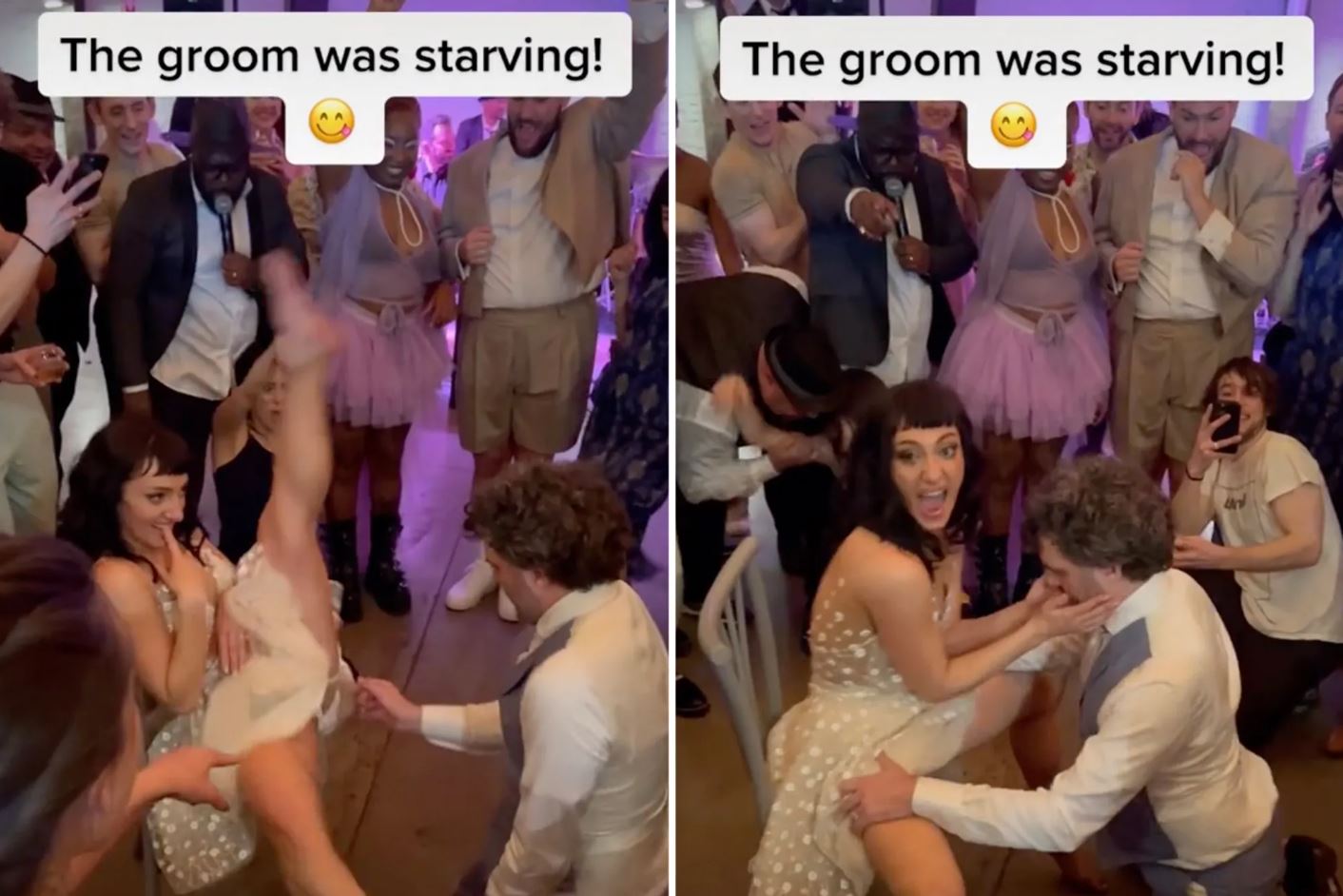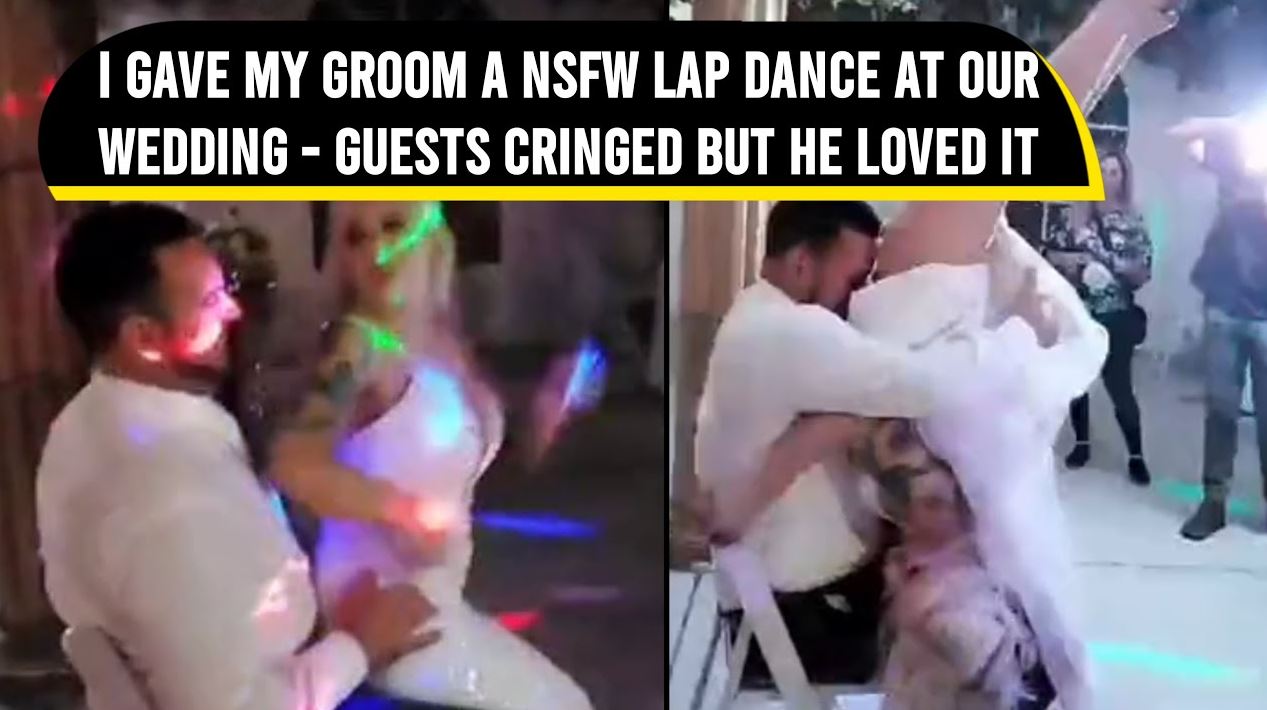I Gave My Groom A Nsfw Lap Dance At Our Wedding Guests Cringed But He Loved It
Weddings are special occasions filled with love, joy, and celebrations, but they can also include unexpected moments that leave guests surprised. One such moment occurred when Natalie Sanders decided to surprise her groom with an NSFW lap dance during their wedding reception. While her husband appeared to enjoy the performance, the reactions from guests were mixed, with some cringing and others cheering her on. The incident quickly gained attention after a video of the lap dance went viral on TikTok, sparking a heated debate on whether such performances are appropriate at weddings.
The video, shared by Sanders herself, showed her dancing provocatively for her groom while dressed in her wedding gown and sandals. The dance, intended as a playful and intimate moment between the newlyweds, took center stage at the reception, capturing the reactions of onlookers. Some guests appeared amused, while others seemed uncomfortable, unsure of how to react to the unexpected performance.
As the video gained traction on social media, it received over 4.8 million views, with users flooding the comment section with their opinions. Some viewers applauded Sanders for her confidence and ability to entertain, while others criticized the performance as inappropriate for a family gathering. The debate highlighted differing cultural and personal views on what is considered acceptable at wedding receptions.
This incident raises important questions about modern wedding traditions and boundaries. While some couples embrace unconventional celebrations, others prefer to adhere to more traditional customs. The contrasting opinions on Sanders’ lap dance demonstrate how wedding entertainment choices can be both a personal decision and a public spectacle, especially in the age of social media.
Ultimately, this story is about more than just a dance—it reflects how personal moments can quickly become public discussions. The reactions, both positive and negative, show how society views bold expressions of love and affection, particularly in formal settings. Sanders’ decision to share her moment with the world invited both admiration and criticism, making her wedding dance one of the most talked-about wedding performances on the internet.
The Bride’s Performance
Natalie Sanders’ lap dance for her groom was meant to be a fun, intimate, and entertaining moment during their wedding reception. The bride, wearing her flowing white gown and sandals, took center stage as she confidently danced for her husband in front of wedding guests. Her performance included sensual moves, including straddling the groom, flipping her hair, and grinding to the music while guests watched. The groom, seemingly enjoying the moment, sat back with a smile on his face as he accepted his bride’s surprise performance.
This bold display of affection was not a last-minute decision. Sanders likely planned the lap dance as a special way to entertain her husband and make their wedding day even more memorable. Unlike traditional first dances, which often feature slow and romantic movements, Sanders’ performance was energetic, seductive, and playful, setting a very different tone for the reception.
While her dance was undoubtedly meant to be a lighthearted and passionate expression of love, it also became an unexpected highlight of the wedding. Some guests appeared to enjoy the performance, laughing and clapping, while others were visibly uncomfortable, unsure of how to react to the unexpected display. Weddings are often attended by people of different generations, including older family members, young children, and close friends, making such performances a controversial choice in terms of appropriateness.
The setting of a wedding reception also plays a role in how performances like this are received. Traditionally, wedding entertainment includes speeches, toasts, and carefully choreographed first dances. However, modern couples often seek ways to personalize their celebrations and create unique experiences for themselves and their guests. Sanders’ lap dance was a testament to this modern approach, where couples are more willing to push boundaries and redefine what is considered acceptable in wedding celebrations.
Although Sanders’ groom clearly appreciated the performance, the mixed reactions from guests showed that such a bold choice might not be well received by everyone. The contrast between the groom’s enjoyment and the guests’ discomfort highlights the challenge of balancing personal expression with public expectations at major life events.
Social Media Reaction
When Natalie Sanders posted the video of her lap dance on TikTok, she likely expected some reactions, but the sheer volume of engagement took many by surprise. The video quickly amassed over 4.8 million views, generating thousands of comments and shares. People from around the world weighed in on the performance, and the responses varied significantly.
Many TikTok users praised Sanders for her confidence and boldness. Supporters argued that the wedding day is ultimately about the couple, and as long as the groom was happy, the performance should not be judged harshly. Others admired Sanders’ dancing skills and applauded her for keeping the reception lively and entertaining. Some even commented that they wished they had the confidence to do something similar at their own weddings.
However, not all responses were positive. A significant portion of commenters found the lap dance inappropriate for a wedding setting, particularly in front of family members, older relatives, and children. Critics argued that a wedding reception is meant to be a more formal and family-friendly event, and Sanders’ performance crossed a line. Some viewers described the dance as embarrassing, while others cringed at the thought of witnessing such a display at their own family gatherings.
The debate extended beyond just the appropriateness of the dance itself. Some people questioned whether social media has influenced modern weddings to become more about viral moments than meaningful celebrations. With many couples now sharing intimate details of their weddings online, some argued that the pressure to stand out can lead to increasingly unconventional choices.
The viral nature of the video also highlighted the role of social media in shaping public opinion. What may have been a personal moment between a bride and groom quickly turned into an internet-wide discussion on wedding etiquette and decorum. The ability to capture and share these moments in real-time means that private celebrations can become public controversies within hours.
Despite the mixed reactions, Sanders remained unapologetic about her decision. She continued to engage with commenters on her video, even responding to some of the criticism with humor. Her confidence in owning her moment demonstrated that, for her, the most important thing was making her husband happy—even if it meant some guests felt uncomfortable.
The social media reaction to Sanders’ lap dance underscores the evolving expectations surrounding weddings and public displays of affection. While some people embrace modern, unconventional celebrations, others remain attached to traditional norms. The discussion sparked by Sanders’ performance reflects broader societal debates about where to draw the line between personal expression and public decorum.
Positive Feedback
Despite the controversy surrounding Natalie Sanders’ lap dance, many people supported her bold decision. A large number of social media users and wedding attendees praised her confidence, viewing the dance as a fun and lighthearted way to entertain her husband on their special day. The argument in favor of her performance centered around the idea that weddings should be about the couple and their happiness, rather than conforming strictly to tradition.
Many TikTok commenters applauded Sanders for embracing her personality and not being afraid to express herself in a way that made her and her groom happy. Some users even admitted that they wished they had the courage to do something similar at their own weddings. They appreciated her willingness to break away from tradition and inject fun into the event, rather than sticking to rigid formalities. For these supporters, the performance symbolized a modern approach to marriage—one where couples prioritize their personal connection over societal expectations.
Others pointed out that the groom’s reaction was what truly mattered. Since he appeared to enjoy the performance, they believed that any criticism from guests or social media users was irrelevant. Some commenters joked that he was “the real winner of the night,” emphasizing that the dance was meant as a special, intimate moment for the newlyweds rather than for the approval of the audience.
Additionally, some viewers focused on Sanders’ physical strength and skill in executing the dance moves. Many noted that performing a lap dance—especially in a wedding dress—required impressive balance and coordination. Some praised her ability to remain graceful and confident despite the unexpected attention and mixed reactions.
In the end, the positive feedback highlighted a key theme: weddings should reflect the personalities of the couple getting married. Supporters of Sanders’ performance emphasized that as long as she and her husband were happy, that was what mattered most. Their perspective challenges the idea that weddings must follow a strict, formal script, instead encouraging couples to celebrate in whatever way feels most authentic to them.
Negative Feedback
While many people supported Sanders’ lap dance, a significant number of guests and online viewers found it inappropriate. Critics argued that weddings are typically family-friendly events, attended by grandparents, parents, and children, making such an overtly sensual performance unsuitable for the occasion. For them, Sanders’ dance crossed a line, making the reception uncomfortable for many attendees.
One of the most common criticisms was that the performance was disrespectful to older relatives. Many people commented that they would be mortified if they had to witness something similar at a family member’s wedding, particularly in the presence of parents or grandparents. Some described the lap dance as “cringeworthy” and said they would have left the event if they had been in attendance.

Another point of criticism was that the lap dance shifted the focus away from the wedding’s intended meaning. Weddings are often seen as sacred ceremonies meant to celebrate love, commitment, and family. Detractors felt that Sanders’ performance cheapened the occasion, making it feel more like a nightclub event than a wedding reception. Some viewers questioned whether social media has contributed to a trend where weddings are becoming more about creating viral moments than about genuine celebration.
Several people also criticized the lack of consideration for the guests. They argued that even if Sanders and her groom enjoyed the dance, she should have taken into account the comfort level of those watching. Unlike private celebrations where such a performance might be expected, a wedding reception includes a diverse group of attendees with different backgrounds, making it important to maintain a balance between personal expression and respect for the audience.
Lastly, some critics focused on the idea that there is a time and place for everything. While they acknowledged that lap dances can be a fun and intimate expression of love between partners, they felt that a wedding reception was not the appropriate setting for such a display. Some suggested that a more traditional first dance, followed by a private lap dance in a more intimate setting, would have been a better way to handle the situation.
Overall, the negative feedback reflected a broader debate on how much personal expression should be allowed at public events. While some people believe that couples should celebrate their wedding however they please, others feel that certain traditions and social norms should be respected, especially in the presence of family and friends.
The Footwear Highlight
Amid all the controversy surrounding the lap dance itself, one unexpected detail in the video caught the attention of many viewers: Natalie Sanders’ choice of footwear. Instead of wearing high heels or elegant bridal shoes, Sanders performed her dance in a pair of simple, casual sandals—quickly dubbed “Jesus slippers” by social media users. This unexpected detail became a humorous talking point among commenters, sparking a separate discussion apart from the lap dance debate.
Some viewers found the sandals amusing, noting the contrast between her bold, sensual dance and the relaxed, everyday footwear. One viral comment joked, “She gave a whole lap dance in those Jesus sandals, I’m weak,” while another playfully added, “It’s the sandals for me.” The mix of casual footwear with such an unexpected performance only added to the internet’s fascination with the video.

Others speculated about the reason behind her footwear choice. Some suggested that she prioritized comfort over fashion, choosing sandals to make it easier to move freely during her performance. Given that wedding days are long and often require hours of standing and dancing, Sanders might have opted for practicality over tradition.
However, some critics argued that the sandals made the entire performance seem less classy. For them, the footwear reinforced the idea that the dance was not well thought out and contributed to the perception that it was inappropriate for a wedding setting. Some commenters humorously remarked that if she was going to perform a lap dance, she should have at least worn proper high heels to match the aesthetic.
Despite the controversy surrounding the performance, the sandals became a lighthearted aspect of the viral discussion. Even those who disagreed with the lap dance found the footwear choice amusing, showing how minor details in viral videos can sometimes take on a life of their own. In a way, the sandals provided a comedic relief from the heated debates about wedding decorum, reminding viewers that sometimes, even the most unexpected details can capture people’s attention.
Natalie Sanders’ wedding lap dance became an internet sensation, sparking debates about wedding etiquette, personal expression, and the influence of social media on modern celebrations. While some applauded her confidence and viewed the dance as a playful moment between newlyweds, others found it inappropriate and uncomfortable for a family event. The polarized reactions highlight the evolving nature of wedding traditions, where couples increasingly choose to personalize their ceremonies in unconventional ways.
The strong opinions on both sides demonstrate the broader divide between traditional and modern wedding expectations. While older generations might prefer a more formal approach to celebrations, younger couples often seek ways to make their weddings unique and fun. This debate is not just about Sanders’ lap dance—it reflects a larger shift in how weddings are perceived and celebrated in today’s world.
Social media played a major role in amplifying the discussion, turning a personal wedding moment into an international topic of conversation. The ability to instantly share and react to events has changed how we engage with weddings, making them not just intimate celebrations but also potential viral spectacles. The lap dance, whether seen as bold or inappropriate, became another example of how the internet influences cultural perceptions.
At the heart of the controversy is a simple question: should weddings be about the couple’s happiness, or should they also consider the comfort of their guests? There is no universal answer, as every couple has different values, traditions, and expectations. What is seen as inappropriate by some may be completely acceptable to others, depending on cultural and personal perspectives.
In the end, Sanders’ performance will likely be remembered as one of the most talked-about wedding moments in recent years. Whether people loved or hated it, it undeniably sparked conversations about love, personal expression, and the evolving nature of wedding celebrations.
EN -Salice Rose Nude Unveiling The Allure Of Art And The Impact On Artistic Expression
Airikacal Unveiling The Allure Of Nude Art And The Impact On Artistic Expression
Aida Victoria Merlano Horse Video Pesona Dunia Kuda Dalam Video Viral
Aida Victoria Merlano Video Caballo En Twitter Es Real El Clip Viral
Rose Hart Nude Unveiling The Allure Of Art And The Impact On Artistic Expression
Sadie Mckenna Nude Unveiling The Allure Of Art And The Impact On Artistic Expression
The Rise Of Desi Viral Mms Videos Capturing Cultural Conversations


 | Sitemap | Mail
| Sitemap | Mail